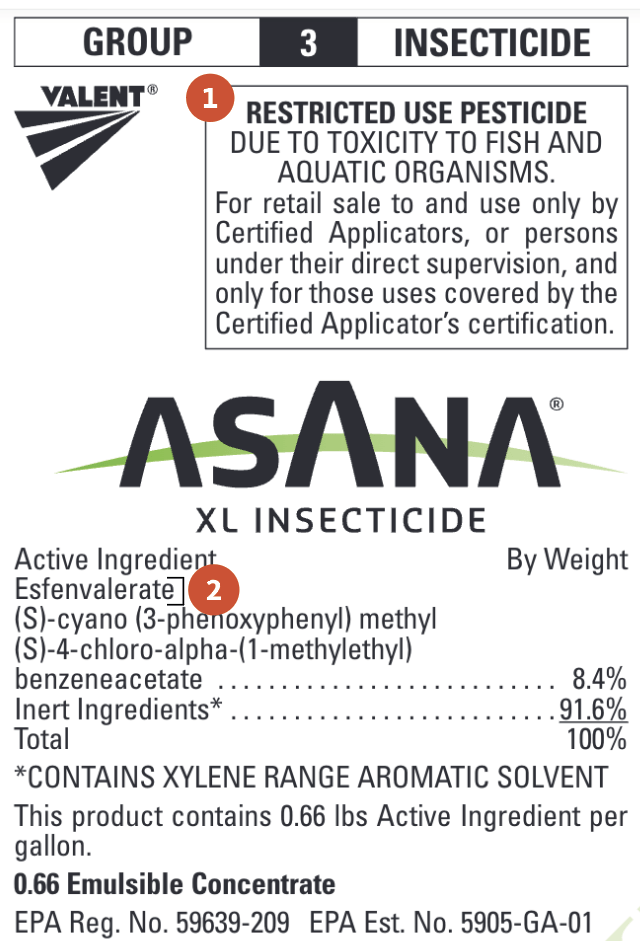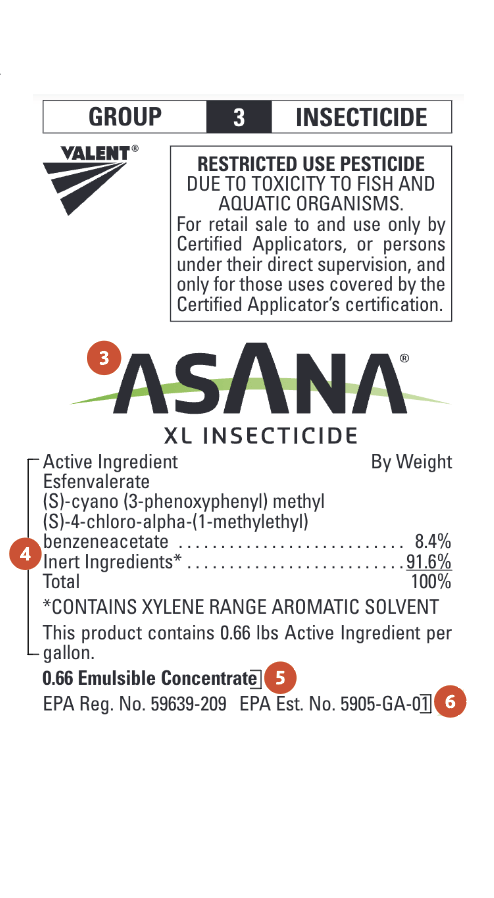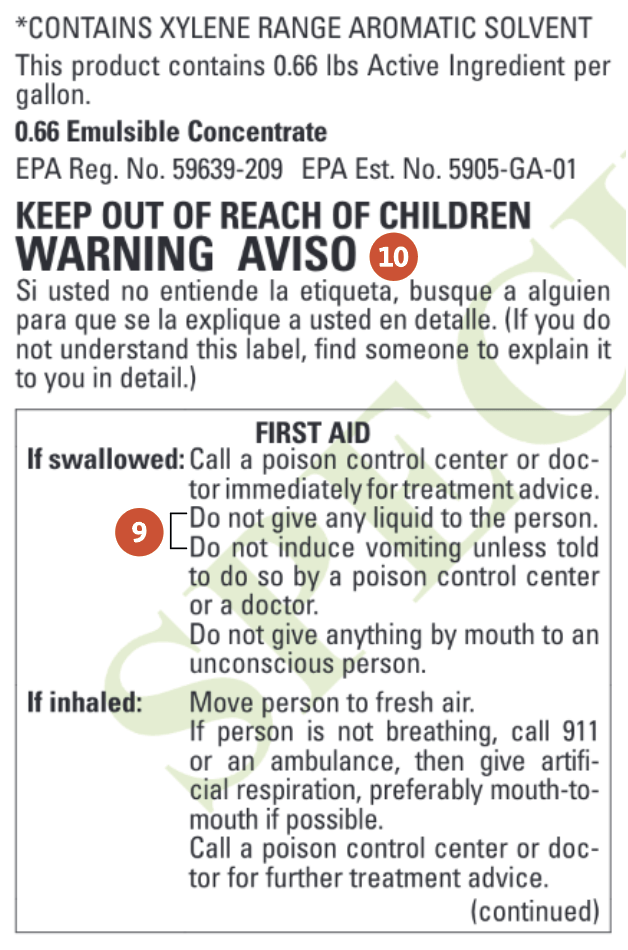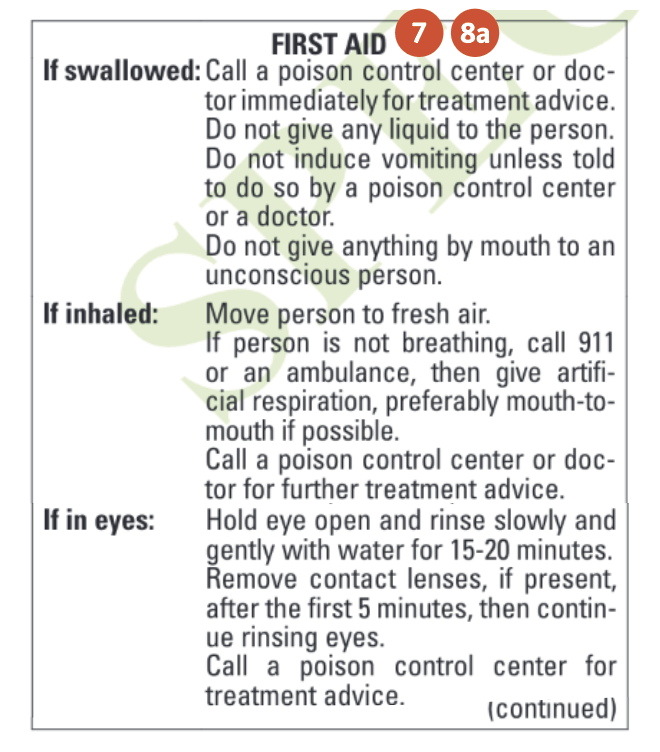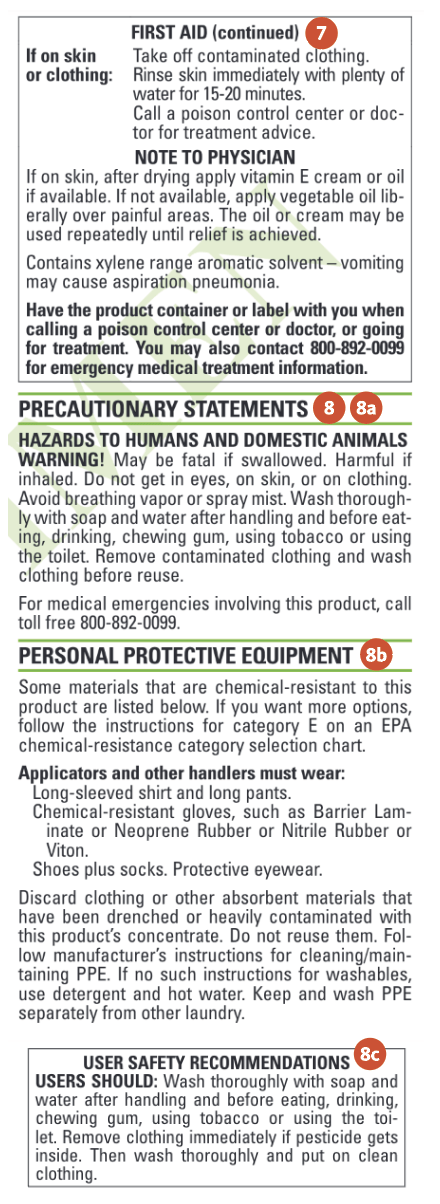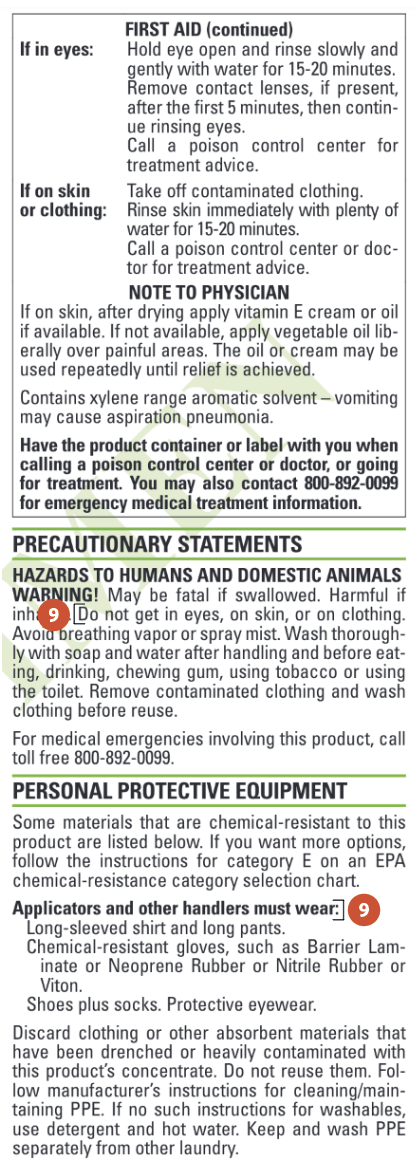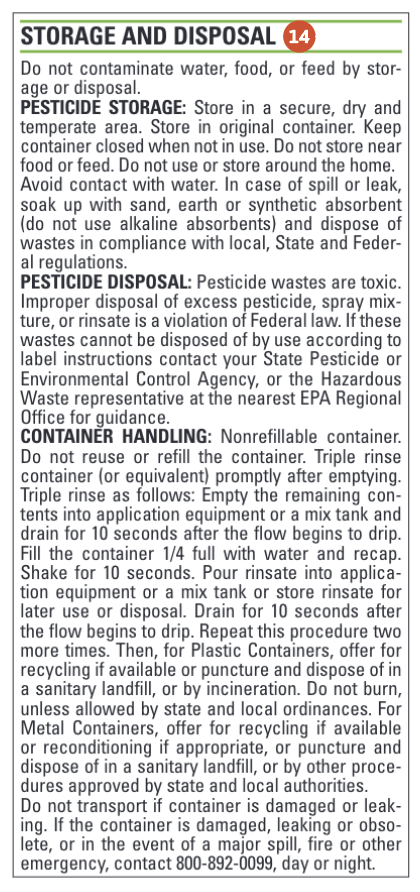Introduction
Applications of pesticides, both conventional and organic, can be a practical part of an integrated pest management plan when used appropriately. Incorrect use of pesticides can lead to problems with human health, crop production and environmental damage. Pesticide labels contain important information for keeping people who work with and near them safe and minimizing negative environmental impacts. This guide provides a roadmap to help pesticide applicators and handlers understand how to use pesticides more safely and effectively. When using pesticides, it is important to remember: the label is the law — it is a legally binding agreement between the applicator, manufacturer or registrant and state and federal regulatory agencies.
This document is designed to serve as a guide to help understand the labels of an element. In this document, sections of the label for “ASANA XL” are used for example purposes only.
1. Classification
Pesticides are restricted use (RUP) or Unclassified (general use). Restricted use pesticides typically pose a high risk to the applicator, the environment, or both and require a license to purchase. If a pesticide is labeled as restricted use, it will say on the first page RESTRICTED USE PESTICIDE or RUP.
2. Common name
The common name refers to a pesticide product’s active ingredient. Using the common name makes it easier to recognize the active ingredient (a.i.) in a pesticide product. For example, esfenvalerate is the common name of the active ingredient in ASANA XL herbicide. Esfenvalerate is also found in pesticide products with brand names such as FenvaStar Plus, S-Fenvalo Star and FenvaStar EcoCap. These products are often referred to by the common name “esfenvalerate” as that is the active ingredient in each product. The common name and the chemical name, the full name of the active ingredient, for the a.i. appear in the ingredient list on the front panel of the label. A.i. concentrations and labeled uses may differ between different brand names.
3. Brand name
The brand name of a given pesticide product comes from the manufacturer. It is visible on the front panel of the label. Many manufacturers can produce pesticides with the same active ingredients. For example, the pesticide products ASANA XL and FenvaStar Plus contain the same active ingredient, esfenvalerate, but are made or sold by different manufacturers. Pesticide product labels with the same active ingredient may have different registered uses. It is up to the handler to know that the chosen product is legal to use for a particular pest management problem.
4. Ingredients list
Pesticide products are composed of two parts: active ingredients and inert ingredients. The active ingredient is the component developed to suppress or control pests. Some pesticide active ingredients are toxic; they may be unstable and could fall out of solution over time without additional stabilization. Inert ingredients in a pesticide help stabilize the product, increase the efficacy and enable more efficient use of the product. Inert ingredients are not required to be listed by name since they do not provide pest control. Inert ingredients may include solvents, emulsifiers, carriers, propellants, fragrances, dyes or otherwise “non-active” ingredients. While non-active ingredients do not control pests, they may still be toxic or dangerous to humans and the environment when not handled appropriately.
5. Formulations
The pesticide formulation is the physical form and composition, the active and inert ingredients, of the pesticide. Pesticides can be sold as concentrates, more suitable for large areas, or ready-to-use products, which are more suitable for home use. Concentrates can come in various liquid or dry forms. They must be mixed with water or another carrier before being applied. Individual formulations often require different mixing practices and application equipment. These requirements are detailed in the label’s “Directions for Use” section. Different formulations of the same pesticide a.i. may also have different potential health and environmental impacts and require other distinct first-aid treatments. These will be described in the “Environmental Hazards” and “First-aid statements” sections. Pay extra attention to the signal words for different formulations of the same a.i.
6. EPA registration numbers
Pesticide products used in the United States are registered with the Environmental Protection Agency. Each pesticide product is given a specific registration number. The registration number is located near the brand name on the front panel of the label. You can use the EPA registration number to look up information about the pesticide being used. It is the key identifier respondents use in case of an emergency such as a spill or contaminator exposure to a pesticide.
7. First-aid statements
First-aid statements include instructions on what to do if a pesticide is inhaled, is swallowed, or comes in contact with clothes or skin. First-aid statement boxes usually include a number to contact in case of exposure. Always have the label with you when contacting poison control or other emergency services.
8. Precautionary statements
Precautionary statements provide details of the hazard concerns for humans and domestic animals if exposed to a particular pesticide product. They also recommend personal protective equipment needed to avoid exposure. The three main types of precautionary statements are described below.
8a. Route of entry statements
Route of entry statements indicate ways the pesticide can enter the body that are most hazardous to applicators.
8b. Personal protective equipment
Pesticide labels feature a box indicating the personal protective equipment required when mixing and applying pesticides. Always wear a long-sleeved shirt, pants, safety glasses,closed-toed shoes or chemical resistant boots while working with pesticides. See the resources portion of this publication for a PPE selection guide from Oregon OSHA.
8c. Action statements
Action statements communicate how to best prevent the pesticide from entering the body through the most hazardous route of entry.
9. Mandatory statements
Mandatory statements are found throughout the label. By law, they must be followed to avoid uses inconsistent with label instructions. These statements usually communicate instructions related to protecting human health and environmental safety. They use directive language, including words and phrases like “must” and “do not”.
10. Signal words
Signal words give the applicator or handler an easy and immediate indication of the pesticide’s acute toxicity to humans. The signal words you might see on a pesticide label in order of most to least toxic are: DANGER-POISON, DANGER, WARNING and CAUTION. Signal words will accompany a statement providing brief guidance about how to store the chemical or treat exposure. Applicators and handlers should refer to the “precautionary statements” section to reduce their likelihood of exposure to a pesticide product.
11. Environmental hazards
The Environmental hazard box outlines potential hazards to animals, fish, plants and insects. This can include specific information about how to protect pollinators during pesticide applications. This box also gives information on specific prohibited actions. For example, a pesticide may have a restriction that it cannot be used within 300 feet of a waterway.
12. Directions for use
The directions for use section of the label communicates where the pesticide can be used, what pests it can control or manage, how to apply it, the maximum amount that can be applied per application or season and pre-harvest interval restrictions.
13. Agricultural use requirements
The agricultural use requirements statement refers to the Worker Protection Standard. These requirements must be met when the product is used in an agricultural setting. The label does not fully describe the WPS but it can be accessed through the EPA website.
14. Storage and disposal
The Storage and Disposal section of the label provides information about how to store and dispose of the pesticide to mitigate against harm to humans and the environment. Pesticides are an expensive investment in crop production. Proper storage reduces the chance of pesticides becoming unusable and creating hazardous waste that requires special disposal efforts.
Supplemental labels
Several pesticide registrations and exemptions allow legal pesticide use in the U.S. The most common is a Section 3 registration. Section 3 registrations grant labels for pesticide use on specific use or target sites or pests. Section 3 labels sometimes only apply in certain states or counties. Oregon supplemental label registrations are granted by the EPA and the Oregon Department of Agriculture Pesticide Division. They can be accessed via the ODA website. Manufacturers must be partners in securing a supplemental label. Once granted, applicators must have such labels when making an application.
Section 24(c), (special local need label)
The Federal Insecticide, Fungicide and Rodenticide Act, Section 24(c), allows for pesticides to be labeled for additional uses, for a new end-use if new conditions exist and for special local needs. Section 24(c) addresses needs that aren’t considered emergencies. For example, an herbicide may effectively control a specific weed in a particular crop. If the herbicide isn’t labeled in that crop, the manufacturer will work with ODA to apply for a 24(c) label. If granted, the 24(c) label would have a time-limited registration that could be renewed or canceled or the new use could be added to the Section 3 label.
Section 18
FIFRA, section 18, allows pesticides not registered for a specific pest problem to be used in an emergency. Section 18 labels allow pesticides to be used in a defined geographic area for a finite amount of time, both of which will be specified on the Section 18 label. An example would be a Section 18 label being released for a newly discovered pest in the area. If the pesticide isn’t labeled in a crop, the manufacturer would work with ODA to apply for a Section 18 label. If granted, the label would have a time limited registration.
Conclusion
Following label instructions is not only legally required, but also the best way to maximize pest control efficacy and safe use of the product. Always read and follow the label when purchasing, applying, storing and disposing of pesticides.
For more information on pesticide labels and uses:
- Contact your local Extension office
- For Spanish label translation: Etiqueta Ahora app
- Hooven L., Ramesh S.R., Johansen, E., 2016. How to reduce bee poisoning from pesticides, Oregon State University.
- Oregon OSHA: Personal Protective Equipment: Selecting the Right PPE for Pesticide Use.
- OSU PACE Course - The Label is the Law: How to Read a Pesticide Label (Worth 1 CORE ODA credit!)
- NPIC Signal Word Fact Sheet

